Blue November Jacket |
||||||||||
 |
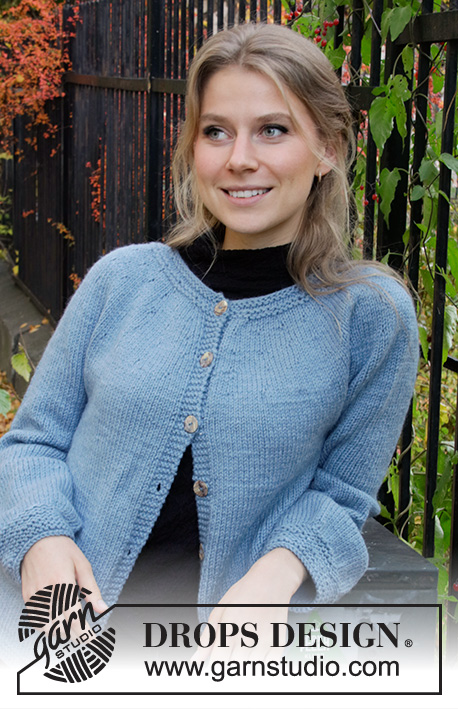 |
|||||||||
Knitted jacket in DROPS Big Merino with round yoke and balloon sleeves. Sizes S-XXXL.
DROPS 205-32 |
||||||||||
|
------------------------------------------------------- EXPLANATIONS FOR THE PATTERN: ------------------------------------------------------- RIDGE/GARTER STITCH (worked in the round): 1 ridge in height = 2 rounds; Knit 1 round and purl 1 round. RIDGE/GARTER STITCH (worked back and forth): Knit all rows. 1 ridge in height = Knit 2 rows. PATTERN: See diagram A.1.Choose diagram for your size. The diagram shows all rows in the pattern seen from the right side. BUTTONHOLES: Work buttonholes on the right band (when the garment is worn). Work from the right side when there are 3 stitches left on the row as follows: Make 1 yarn over, knit 2 together and knit 1. On the next row (wrong side), knit the yarn over to leave a hole. The first buttonhole is worked when the rib on the neck measures approx. 1½-2 cm = ½"-¾". Then work the other 6-6-7-7-8-8 buttonholes with approx. 8-8-7½-7½-7-7 cm = 3⅛"-3⅛"-2⅞"-2⅞"-2¾"-2¾" between each one. INCREASE TIP-1 (for neck): To work out how to increase evenly, count the total number of stitches on the needle (e.g. 84 stitches) minus bands (e.g. 10 stitches) and divide the remaining stitches by the number of increases to be made (e.g. 6) = 12.3. In this example, increase by making 1 yarn over after approx. each 12th stitch. Do not increase on bands. On the next row work the yarn overs twisted to avoid holes. INCREASE TIP-2 (for sides of body): All increases are worked from the right side! Work until there are 2 stitches left before the marker thread, make 1 yarn over, knit 4 (marker thread sits between these 4 stitches) make 1 yarn over (= 2 stitches increased at each marker thread; 4 stitches increased on round). On the next row work the yarn overs twisted to avoid holes. Then work the new stitches in stockinette stitch. DECREASE TIP-1 (for mid under sleeve): Work until there are 3 stitches left before the marker, knit 2 together, knit 2 (marker thread sits between these 2 stitches), slip 1 stitch as if to knit, knit 1 and pass the slipped stitch over the knitted stitch (= 2 stitches decreased). DECREASE TIP-2 (evenly spaced at bottom of sleeve): To work out how to decrease evenly, count the total number of stitches on needle (e.g. 64 stitches) and divide by number of decreases to be made (e.g. 26) = 2.4. In this example decrease by knitting alternately each 1st and 2nd and each 2nd and 3rd stitch together. KNITTING TIP (for sleeve length): The length of the sleeve can be adjusted as described in the text, but be aware that the sleeve length should be slightly longer than usual so the sleeve is a bit baggy at the bottom. ------------------------------------------------------- START THE PIECE HERE: ------------------------------------------------------- JACKET – SHORT OVERVIEW OF THE PIECE: The piece is worked top down. The yoke is worked back and forth with circular needle to where it is divided for body and sleeves. Body and sleeves are finished separately; the body is continued back and forth, the sleeves are worked in the round with double pointed needles. YOKE: Cast on 80-84-86-92-94-100 stitches (including 5 band stitches on each side) with circular needle size 4.5 mm = US 7 and Big Merino. Work GARTER STITCH back and forth – read description above, for 1½ cm = ½". Knit 1 row from the right side and increase 2-6-4-6-4-6 stitches evenly spaced – read INCREASE TIP-1 = 82-90-90-98-98-106 stitches. Knit 1 row from the wrong side. Change to circular needle size 5.5 mm = US 9. Continue from the right side as follows: Work 5 band stitches in garter stitch, A.1 (= 8 stitches) a total of 9-10-10-11-11-12 times in width and finish with 5 band stitches in garter stitch. REMEMBER THE KNITTING GAUGE! When A.1 has been worked 1 time in height there are 217-250-260-296-296-322 stitches on the row. Knit 1 row from the right side where you increase 6-2-8-0-8-13 stitches evenly spaced = 223-252-268-296-304-335 stitches. Work stockinette stitch with band stitches in garter stitch as before until the piece measures 22-24-25-27-29-31 cm = 8¾"-9½"-9¾"-10⅝"-11⅜"-12¼" from the cast-on edge. Now divide the piece for body and sleeves as follows: Work 5 band stitches in garter stitch, 32-35-37-43-45-51 stitches in stockinette stitch (= front piece), place the next 44-51-55-58-58-62 stitches on a thread for sleeve and cast on 8-8-10-10-12-12 stitches under the sleeve, work 62-70-74-84-88-99 stitches in stockinette stitch (= back piece), place the next 44-51-55-58-58-62 stitches on a thread for sleeve and cast on 8-8-10-10-12-12 stitches under the sleeve, work 31-35-37-43-45-51 stitches in stockinette stitch and finish with 5 band stitches in garter stitch (= front piece) = 151-166-178-200-212-235 stitches. BODY: Place 1 marker in the middle of the 8-8-10-10-12-12 stitches under each sleeve (= 2 markers = 70-78-84-94-100-111 stitches on the back piece). Work stockinette stitch with 5 band stitches in garter stitch on each side. When the piece measures 3 cm = 1⅛" from where the body and sleeves were divided increase 1 stitch on either side of both markers – read INCREASE TIP-2 (= a total of 4 stitches increased). Increase like this every 4-4½-4-4-3½-4½ cm = 1½"-1¾"-1½"-1½"-1¼"-1¾" a total of 7-6-7-7-8-6 times = 179-190-206-228-244-259 stitches. When the piece measures 33-33-34-34-34-34 cm = 13"-13"-13⅜"-13⅜"-13⅜"-13⅜" from where body and sleeves were divided, change to circular needle size 4.5 mm = US 7 and work garter stitch over all stitches. Bind off with knit when the piece measures 35-35-36-36-36-36 cm = 13¾"-13¾"-14¼"-14¼"-14¼"-14¼" from the division. SLEEVE: Place the 44-51-55-58-58-62 stitches from the thread on the one side of the piece on double pointed needles size 5.5 mm = US 9 and knit up 1 stitch in each of the 8-8-10-10-12-12 stitches under the sleeve = 52-59-65-68-70-74 stitches. Insert 1 marker in the middle of the 8-8-10-10-12-12 stitches. Work stockinette stitch in the round. When the sleeve measures 3 cm = 1⅛" from the division decrease 1 stitch on each side of the marker – read DECREASE TIP-1! Decrease like this every 10-3-3-3-5-5 cm = 4"-1⅛"-1⅛"-1⅛"-2"-2" a total of 2-4-4-4-3-3 times = 48-51-57-60-64-68 stitches. When the sleeve measures 22-21-20-19-17-16 cm = 8¾"-8¼"-8"-7½"-6¾"-6¼" from the division increase 8 stitches as follows on the next round: * Knit 6-6-7-7-8-8 stitches, 1 yarn over *, work from *-* a total of 8 times and finish with knit 0-3-1-4-0-4 stitches = 56-59-65-68-72-76 stitches. The yarn overs are worked twisted on the next round to avoid holes! When the sleeve measures 24-23-22-21-19-18 cm = 9½"-9"-8¾"-8¼"-7½"-7" from the division increase as follows: * Knit 7-7-8-8-9-9, 1 yarn over *, work from *-* a total of 8 times and finish with knit 0-3-1-4-0-4 stitches = 64-67-73-76-80-84 stitches. Continue working until the piece measures 38-37-36-34-32-31 cm = 16"-14½"-14¼"-13⅜"-12½"-12¼" from the division (there is approx. 5 cm = 2" left to finished length – read KNITTING TIP). NOTE: Shorter measurements in larger sizes due to wider neck and longer yoke. On the next round decrease 26-29-33-34-36-40 stitches evenly space – read DECREASE TIP-2! There are 38-38-40-42-44-44 stitches left on the sleeve. Change to double pointed needles size 4.5 mm = US 7 and work GARTER STITCH in the round for 5 cm = 2" – read description above. The sleeve measures 43-42-41-39-37-36 cm = 17"-16½"-16⅛"-15¼"-14½"-14¼" from where the sleeve was divided from the body. Bind off with knit. Work the other sleeve in the same way. ASSEMBLY: Sew buttons onto left band. |
||||||||||
Diagram explanations |
||||||||||
|
||||||||||
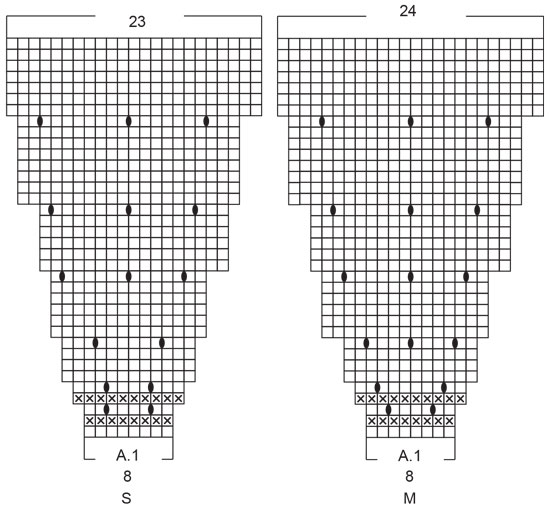
|
||||||||||

|
||||||||||
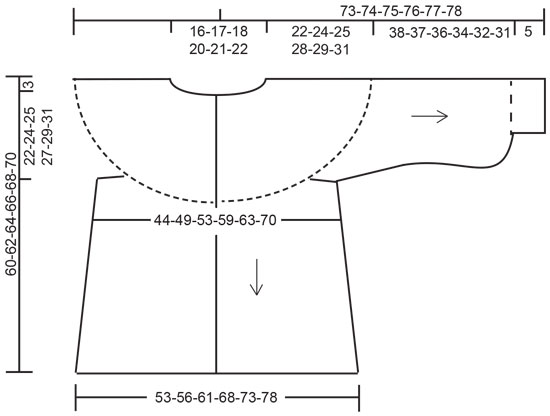
|
||||||||||
|
Have you made this or any other of our designs? Tag your pictures in social media with #dropsdesign so we can see them! Do you need help with this pattern?You'll find tutorial videos, a Comments/Questions area and more by visiting the pattern on garnstudio.com. © 1982-2024 DROPS Design A/S. We reserve all rights. This document, including all its sub-sections, has copyrights. Read more about what you can do with our patterns at the bottom of each pattern on our site. |
||||||||||







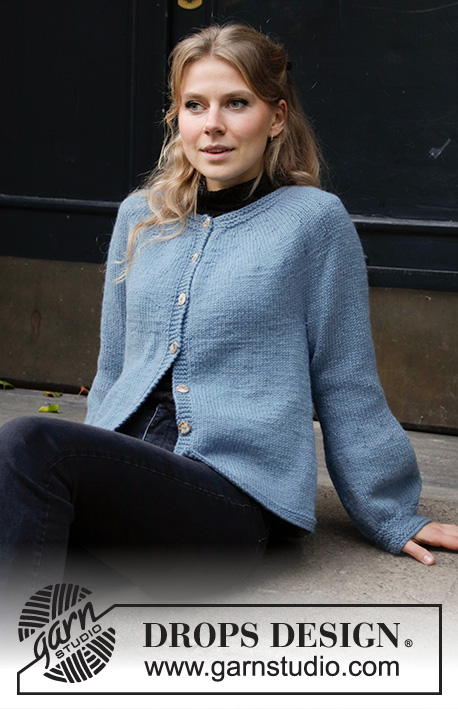





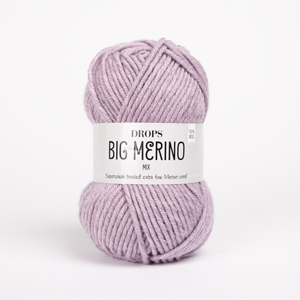
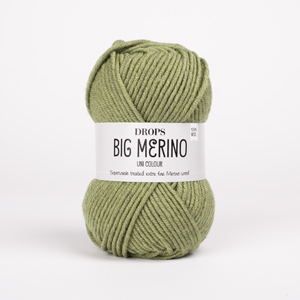
















































Comments / Questions (6)
Når jeg læser A1- er det korrekt, at jeg strikker (linje 5)* 2r-slå om- 3r-slå om-3r- slå om- 2r-*og gentag p. ud.\r\nEller er det 2r-*slå om- 3r-slå om - 3r- slå om- *gentag fra *-*og afslut med 2r.?
19.03.2024 - 12:55DROPS Design answered:
Hei Lisbeth. Du gjentar hele diagrammet. I str. L-XL-XXL-XXXL strikker du slik: * 2r-slå om- 3r-slå om-3r- slå om- 2r*. mvh DROPS Design
02.04.2024 - 09:33When I follow the directions I have 4 garter stitch ridges at the neckline. The picture seems to have only 2. What could I be doing incorrectly?
17.02.2023 - 22:41DROPS Design answered:
Dear Ruth, the instructions are correct, there are 4 garter stitch ridges at the neckline. Happy knitting!
19.02.2023 - 19:41Om jag lägger upp 10 maskor under varje ärm borde antalet maskor bli 188 för fram o bakstycke
02.08.2021 - 23:05Não entendi a explicação do primeiro aumento do encaixe. Pede para aumentar 6 pontos em intervalos regulares mas no gráfico A1 (M), mostra a cada 4.
10.02.2021 - 11:31I laver så mange skønne opskrifter. Forstår bare ikke hvorfor i fravælger størrelse xs når i ellers har op i størrelse XXXL
09.01.2020 - 19:00Hello, looking at the picture I suppose that before starting A1 rows we should knit one row and purl the other side im order to have thr gap between gartner stitches. Am I right? Is there a mistake in the description?
07.09.2019 - 13:04DROPS Design answered:
Dear Zuzanna, after the cast on you'll work garter stithc for 1½ cm, then knit 1 row from the right side with increases and finally knit 1 row from wrong side. Than you can start with A.1 as explained. Knit 1 row from the wrong side. Change to circular needle size 5.5 mm.
08.09.2019 - 10:51